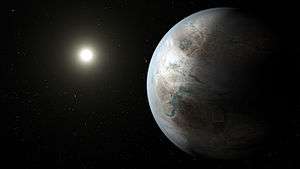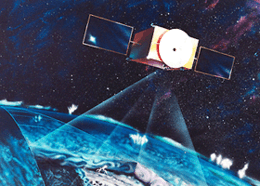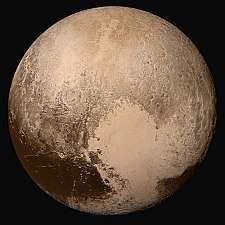Kepler-444
| Observation data Epoch J2000 Equinox 2000 | |
|---|---|
| Constellation | Lyra |
| Right ascension | 19h 19m 01.0s[1] |
| Declination | +41° 38′ 05″[1] |
| Apparent magnitude (V) | 8.86 |
| Characteristics | |
| Spectral type | K0V |
| Astrometry | |
| Radial velocity (Rv) | −121.19±0.11 km/s |
| Proper motion (μ) | RA: 98.94±0.80[1] mas/yr Dec.: −632.49±0.85[1] mas/yr |
| Parallax (π) | 28.03 ± 0.82[1] mas |
| Distance | 116 ± 3 ly (36 ± 1 pc) |
| Details | |
| Mass | 0.758 (± 0.043) M☉ |
| Radius | 0.752 (± 0.014) R☉ |
| Temperature | 5040 (± 74.0) K |
| Metallicity [Fe/H] | -0.55 (± 0.07) dex |
| Rotation | 49.40±6.04 d[2] |
| Age | 11.23 (± 0.99) Gyr |
| Other designations | |
KOI-3158; 2MASS J19190052+4138043; TYC 3129-00329-1; KIC 6278762; LHS 3450; HIP 94931; BD+41 3306 | |
| Database references | |
| SIMBAD | data |
Kepler-444 (or KOI-3158, KIC 6278762, 2MASS J19190052+4138043, BD+41 3306)[3][4][5][6][7][8] is a star, estimated to be 11.2 billion years old (more than 80% of the age of the universe),[6] approximately 116 light-years (36 pc) away from Earth in the constellation Lyra. On 27 January 2015, the Kepler spacecraft is reported to have confirmed the detection of five sub-Earth-sized rocky exoplanets orbiting the star.[3][4][5][7] According to NASA, no life as we know it could exist on these hot exoplanets, due to their close orbital distances to the host star.[3]
Discovery
Preliminary results of the planetary system around Kepler-444 were first announced at the second Kepler science conference in 2013. At that conference, the star was known as KOI-3158.[9]
Characteristics
The star, Kepler-444, is approximately 11.2 billion years old, whereas the Sun is only 4.6 billion years old. The age of Kepler-444, an orange main sequence star of spectral type K0,[8] is more than 80% of the age of the universe.[6]
The original research on Kepler-444 was published in The Astrophysical Journal on 27 January 2015 under the title "An ancient extrasolar system with five sub-Earth-size planets"[10] by a team of 40 authors, the abstract reads as follows:
The chemical composition of stars hosting small exoplanets (with radii less than four Earth radii) appears to be more diverse than that of gas-giant hosts, which tend to be metal-rich. This implies that small, including Earth-size, planets may have readily formed at earlier epochs in the Universe's history when metals were more scarce. We report Kepler spacecraft observations of Kepler-444, a metal-poor Sun-like star from the old population of the Galactic thick disk and the host to a compact system of five transiting planets with sizes between those of Mercury and Venus. We validate this system as a true five-planet system orbiting the target star and provide a detailed characterization of its planetary and orbital parameters based on an analysis of the transit photometry. Kepler-444 is the densest star with detected solar-like oscillations. We use asteroseismology to directly measure a precise age of 11.2+/-1.0 Gyr for the host star, indicating that Kepler-444 formed when the Universe was less than 20% of its current age and making it the oldest known system of terrestrial-size planets. We thus show that Earth-size planets have formed throughout most of the Universe's 13.8-billion-year history, leaving open the possibility for the existence of ancient life in the Galaxy. The age of Kepler-444 not only suggests that thick-disk stars were among the hosts to the first Galactic planets, but may also help to pinpoint the beginning of the era of planet formation."[10] The star is believed to have 2 M dwarfs in orbit around it with the fainter companion 1.8 arc-seconds from the main star.[11]
Stellar system
The Kepler-444 system consists of the planet hosting primary and a pair of M-dwarf stars. The M-dwarfs orbit each other at a distance of less than 0.3 AU while the pair orbits the primary in a highly eccentric 198 year orbit. The pair comes within 5 AU of the primary potentially severely truncating the protoplanetary disk from which the planets formed at 1–2 AU. This would have depleted the availability of solid material to form the observed planets.[12]
Planetary system
All five rocky exoplanets (Kepler-444b; Kepler-444c; Kepler-444d; Kepler-444e; Kepler-444f) are confirmed,[7] smaller than the size of Venus (but bigger than Mercury) and each of the exoplanets completes an orbit around the host star in less than 10 days.[3][6] The system is also very compact and Kepler-444b is the smallest at 0.403 earth diameters, and even the furthest planet, Kepler-444f, still orbits closer to the star than Mercury is to the Sun.[8] According to NASA, no life as we know it could exist on these hot exoplanets, due to their close orbital distances to the host star.[3]
| Companion (in order from star) |
Mass | Semimajor axis (AU) |
Orbital period (days) |
Eccentricity | Inclination | Radius |
|---|---|---|---|---|---|---|
| b | — | 0.04178 | 3.60001053 | 0.16 | 88° | 0.4 R⊕ |
| c | — | 0.04881 | 4.5458841 | 0.31 | 88.2° | 0.497 R⊕ |
| d | 0.036+0.065 −0.020 M⊕ |
0.06 | 6.189392 | 0.18 | 88.16° | 0.53 R⊕ |
| e | 0.034+0.059 −0.019 M⊕ |
0.0696 | 7.743493 | 0.1 | 89.13° | 0.546 R⊕ |
| f | — | 0.0811 | 9.740486 | 0.29 | 87.96° | 0.741 R⊕ |
See also
- Kepler-80 - most compact 5-planet system discovered so far
- List of extrasolar planets
- PSR B1620-26 - a possible ancient planetary system in Messier 4
References
- 1 2 3 4 5 van Leeuwen, F. (2007). "Validation of the new Hipparcos reduction". Astronomy and Astrophysics. 474 (2): 653–664. arXiv:0708.1752. Bibcode:2007A&A...474..653V. doi:10.1051/0004-6361:20078357. Vizier catalog entry
- ↑ Mazeh, Tsevi; et al. (2015). "Photometric Amplitude Distribution of Stellar Rotation of KOIs—Indication for Spin-Orbit Alignment of Cool Stars and High Obliquity for Hot Stars". The Astrophysical Journal. 801 (1). 3. arXiv:1501.01288. Bibcode:2015ApJ...801....3M. doi:10.1088/0004-637X/801/1/3.
- 1 2 3 4 5 Johnson, Michele (28 January 2015). "Astronomers Discover Ancient System with Five Small Planets". NASA. Retrieved 29 January 2015.
- 1 2 Dunn, Marcia (27 January 2015). "Astronomers find solar system more than double ours in age". AP News. Retrieved 27 January 2015.
- 1 2 Atkinson, Nancy (27 January 2015). "Oldest Planetary System Discovered, Improving the Chances for Intelligent Life Everywhere". Universe Today. Retrieved 27 January 2015.
- 1 2 3 4 Wall, Mike (27 January 2015). "Found! 5 Ancient Alien Planets Nearly As Old As the Universe". Space.com. Retrieved 27 January 2015.
- 1 2 3 4 Staff (27 January 2015). "Exoplanet Catalog". Extrasolar Planets Encyclopaedia. Retrieved 27 January 2015.
- 1 2 3 Phil, Plait (28 January 2015). "Astronomers Find Ancient Earth-Sized Planets in Our Galactic Backyard". Slate. Retrieved 28 January 2015.
- ↑ Staff (8 November 2013). "Second Kepler Science Conference - NASA Ames Research Center, Mountain View, CA - Nov. 4-8, 2013 - Agenda". Caltech. Retrieved 28 January 2014.
- 1 2 Campante, T.L.; et al. (27 January 2015). "An Ancient Extrasolar System with Five Sub-Earth-size Planets". Astrophysical Journal. 799 (2). arXiv:1501.06227. Bibcode:2015ApJ...799..170C. doi:10.1088/0004-637X/799/2/170. Retrieved 2 February 2015.
- ↑ Campante, Tiago (18 September 2014). "An ancient extrasolar system with five sub-Earth-size planets" (PDF): 6–15. Retrieved 2 February 2015.
- ↑ Dupuy, Trent J.; et al. (2016). "Orbital Architectures of Planet-Hosting Binaries. I. Forming Five Small Planets in the Truncated Disk of Kepler-444A". The Astrophysical Journal. 817 (1). 80. arXiv:1512.03428. Bibcode:2016ApJ...817...80D. doi:10.3847/0004-637X/817/1/80.
- ↑ Mills, Sean M.; Fabrycky, Daniel C. (2017). "Mass, Density, and Formation Constraints in the Compact, Sub-Earth Kepler-444 System including Two Mars-mass Planets". The Astrophysical Journal Letters. 838 (1). L11. arXiv:1703.03417. Bibcode:2017ApJ...838L..11M. doi:10.3847/2041-8213/aa6543.
External links
| Wikimedia Commons has media related to Kepler Mission. |


